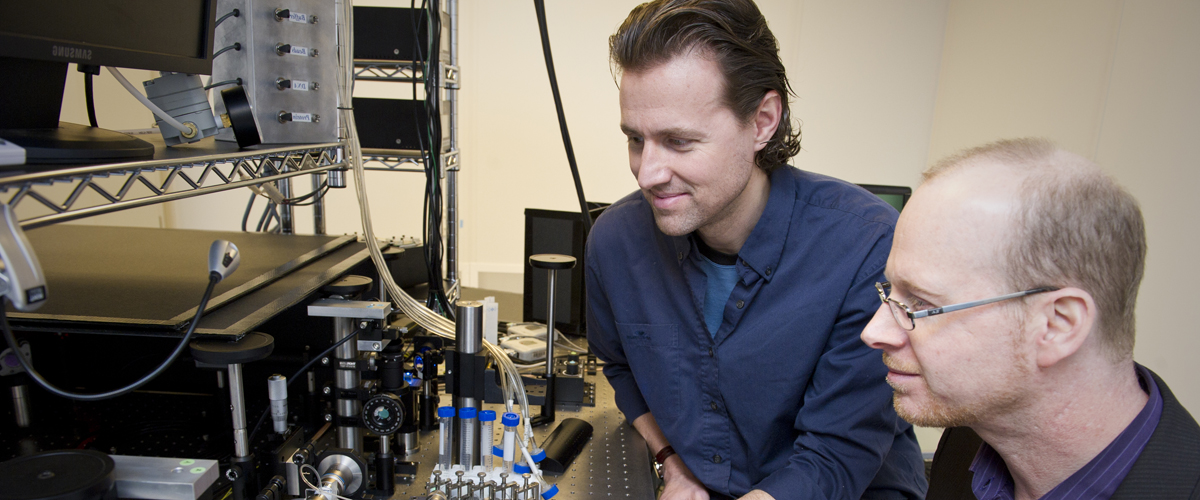by Angela Herring
More than 35 million people around the world now live with HIV/AIDS. While drug discovery efforts to combat the disease have been successful, multiple treatments are required because the virus mutates and develops resistance to individual drugs. In fact, the HIV virus has evolved to evade the first line of defense—a protein called APOBEC3G, also known as A3G. Now, in a paper published last week in the journal Nature Chemistry, physics professor Mark Williams and his team present new research that elucidates a long-held paradox about these proteins that could transform HIV drug discovery.
What did you learn about A3G, and how could your findings inform HIV/AIDS drug discovery?
The A3G proteins are normally fast acting enzymes that inhibit HIV’s ability to infect us by mutating the viral DNA at specific points throughout the genomic sequence. Unfortunately, HIV has a protein called Vif that tricks the cell into destroying its own A3G. To get around this defense mechanism, one could imagine developing a drug that mimics A3G activity. However, the enzyme activity of A3G is just too complicated to mimic, so knowing how A3G works doesn’t help us battle HIV—until now. In our new paper, we show that A3G can also be a slow binding protein, retaining its ability to stop HIV in its tracks—even without A3G’s enzyme activity. Using a laser-based analytical probe called optical tweezers, we found that over time, A3G proteins group together to form slow-acting modules that remain bound to the HIV genomic RNA or DNA and act as roadblocks against its replication. It may now be possible to develop drugs that mimic this roadblock activity, or to enhance the roadblock activity of A3G while also developing a drug that targets Vif.
What sparked the initial hypothesis here, and how did you go about testing it?
My group has a research grant from the National Institutes of Health to use our single molecule methods to study DNA and RNA interactions with proteins involved in HIV replication. There was some evidence from work with cells that A3G could inhibit HIV-1 replication even when it didn’t have its enzymatic activity. To find out how this could be, one of our collaborators, Judith Levin from NIH, developed a way of obtaining A3G for study in the lab. Her lab did some biochemical work that led to the hypothesis that there was this roadblock activity. However, they could not prove it directly, and many researchers thought that the ability of A3G to inhibit HIV-1 was not a real effect but instead an artifact of the way the experiments were done.
The reason people didn’t believe it was that it didn’t make physical sense. How could an enzyme that has to move up and down the genome rapidly to chemically modify over a thousand bases in the HIV genome also form a roadblock, which requires it not to move rapidly? Our collaborator Ioulia Rouzina, a biophysical theorist from the University of Minnesota, came up with the hypothesis that maybe it starts off fast, and becomes slower over time. We then set out to prove this using our optical tweezers measurements, which allowed us to show directly not only that the protein gets slower over time, but we also showed that this was due to the binding of several proteins to each other over time on our single DNA molecule.
What are the next steps for this research, both in terms of HIV treatment and its impact in other, non-AIDS related areas?
In terms of HIV drug development related to A3G, we still have a lot to do. It is remarkable that we have known for years that we have a protein that potentially makes us immune to HIV, but we still do not understand some of its basic properties. Now that we have made a leap forward in our understanding of A3G, it will still be a lot of work to use this knowledge for drug development. However, this work does demonstrate a new way to battle HIV, so it should be possible to find new drugs to do something similar.
It is possible that this is a more general mechanism for changing a protein’s properties. This would allow other proteins to work like A3G, and could apply in many other instances that require an enzyme to assume multiple roles. There is actually a whole class of APOBEC proteins. For example, APOBEC3A seems to inhibit retrotransposons, which are genomic parasites that make up a high percentage of the human genome. It is possible that other members of the APOBEC family also have the ability to form roadblocks, and this is something we would like to study in the future.
Originally published at news@Northeastern on December 2, 2013.

